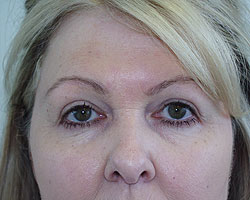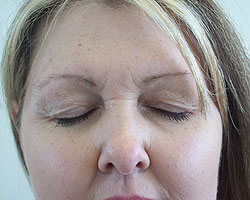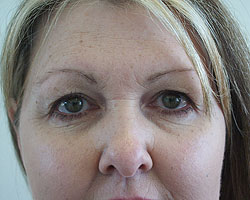Blepharoplasty (Eyelid Surgery)
Blepharoplasty can rejuvenate puffy, sagging or tired-looking eyes by removing excess fat, skin and muscle from the upper and lower eyelids. It may be performed for cosmetic reasons or to improve sight by lifting droopy eyelids out of the patient's field of vision. The procedure is usually performed in an office with local anesthesia in as little as 45 minutes. Blepharoplasty can be combined with a facelift or BOTOX® treatments to raise the eyebrows or reduce the appearance of wrinkles, crow's feet or dark circles under the eyes.
Before


After


Facelift (Rhytidectomy)
In time, gravity, sun exposure, and the stresses of daily life take their toll on our faces: deep creases appear beside the mouth, the jaw line slackens, and folds and fat deposits appear on the neck. Facelifts counteract these problems by removing fat and tightening skin and muscles, giving your face a fresher, youthful look. Incisions are made in inconspicuous places such as behind the hairline and in natural folds of the face and ears, and scars fade to near invisibility in time. After surgery, some patients appear 10-15 years younger.
Forehead Lift (Browlift)
Browlifts can revitalize drooping or lined foreheads, helping you to look less angry, sad or tired. Using either traditional or minimally invasive (endoscopic) methods, the muscles above the eyes are altered to smooth lines and raise the eyebrows for a more youthful appearance. The procedure is often combined with other operations such as blepharoplasty and facelifts to improve the look of the eyes and other areas of the face.
Skin Cancer
Skin cancer refers to the abnormal, uncontrolled growth of skin cells. One in five people will develop skin cancer in their lifetime, according to the American Academy of Dermatology. Risk factors include pale skin, family history of melanoma, being over 40 years old, and regular sun exposure. Fortunately, skin cancer is almost always curable if detected and treated early.
The most common skin cancers are:
- Basal cell carcinoma - 80-85% of all skin cancers. Basal cell carcinoma affects cells in the lowest layer of the epidermis.
- Squamous cell carcinoma - 10% of all skin cancers. Squamous cell carcinoma affects cells in the middle layer of the epidermis.
- Melanoma - 5% of all skin cancers. Melanoma is a rare but very dangerous type of skin cancer. It is the leading cause of death from skin disease.
Skin cancers vary in shape, color, size and texture, so any new, changed or otherwise suspicious growths or rashes should be examined immediately by a physician. Early intervention is essential to preventing the cancer from spreading.
Scar Revision
Although no scar can be completely removed, reconstructive surgeons have developed methods affective in improving the appearance of a scar by minimizing its visibility. The development of a scar depends on the size and depth of the wound, the remaining blood supply to the area, the thickness and pigmentation of the skin and the direction of the scar. Injections, steroid medications and/or scar revision surgery can help reduce the appearance of the following scars on many parts of the body:
- Keloid Scars: Keloid scars are puckered, thick, itchy clusters of scar tissue that grow around and beyond the edges of a surgical incision or wound. Typically red or darker in color than the surrounding skin, these scars develop when the body produces collagen after a wound has healed.
- Hypertrophic Scars: Usually thick, red and raised, Hypertrophic scars are similar to keloid scars. However, they do not grow beyond the boundaries of a wound.
- Contractures: Burns or other injuries can result in the loss of a considerable amount of skin, forming a scar that pulls the edges of skin together. This process is known as contracture. Contractures can affect adjacent muscles and tendons, leading to a restriction in movement.
Cleft Lip & Palate Surgery
Dr. Downey discussing the Cleft Lip & Palate techniques taught to Ecuadorian residents.
Surgery to repair cleft lip and/or cleft palate in infants can correct nursing, feeding and speech problems, frequent ear infections and physical disfigurement with dramatic aesthetic and functional results. The cleft lip procedure is usually performed at 6-12 weeks of age, while cleft palate surgery is performed between the ages of nine months and one year (after the palate has grown but before faulty speech habits are acquired).
While the infant sleeps under general anesthesia, the cleft is closed with absorbable stitches. The skin is then sewn over the correction with fine sutures to minimize scarring. Speech therapy may be required for children with residual muscle problems resulting from cleft palate.

